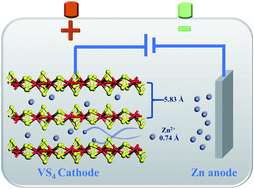VS4 with a chain crystal structure used as an intercalation cathode for aqueous Zn-ion batteries†
Abstract
Non-aqueous lithium-ion batteries are currently widely used throughout society, but aqueous batteries could be more feasible for grid-scale applications or even electric cars when factors like cost and safety are taken into consideration. Rechargeable aqueous zinc-ion batteries are promising energy storage devices due to their high energy density, safety, environmental friendliness, and low cost. However, their development for commercial applications remains in the beginning stages because of the limited options among positive electrodes exhibiting adequate capacity and cycle life. Furthermore, their energy-storage mechanisms are not yet well established. Here, vanadium tetrasulfide (VS4) with a beneficial one-dimensional atomic-chain structure is reported to be able to serve as a favorable intercalation cathode material for high-performance Zn-ion batteries. The energy-storage mechanism was investigated both theoretically and experimentally. The maximum capacity of this material reaches 310 mA h g−1 and 85% of this capacity remains even after 500 cycles, which is promising for future practical applications.



 Please wait while we load your content...
Please wait while we load your content...